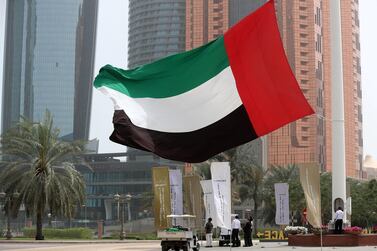Abu Dhabi’s economy is expected to grow by 2 per cent this year and expand by an average of 2.5 per cent until 2022 supported by higher oil production and continued spending by the government that will boost non-oil economic growth.
The gross domestic product (GDP) of Abu Dhabi, whose crude output accounts for 4.2 per cent of global production, is projected to rise to 3 per cent by 2022, S&P Global rating said in its latest report on the emirate. Sustained investments in both oil and non-oil sectors of the emirate and recovering domestic credit growth bolstered by improving demand in the Arabian Gulf region, will propel growth over the next three years, the rating agency said on Sunday.
“Following several years of expenditure rationalisation, we expect the government will moderately increase spending to support a revival in growth,” which will average 2.5 per cent over 2019-2022, S&P said.
Last year Abu Dhabi's government said it would roll out a three-year Dh50 billion stimulus package, equivalent to about 1.8 per cent of its annual GDP, to spur economic growth, encourage foreign investment and improve the business environment in the emirate. In a landmark move last month, the government said it will offer UAE permanent residency to expatriates that meet certain requirements. The government's move followed other steps taken to bolster the country's attractiveness to foreigners such as 100 per cent foreign ownership for expatriates in certain sectors including real estate and reducing the costs of business licenses.
S&P, which rates Abu Dhabi AA with a stable outlook, said its rating reflects its view of the emirate’s strong fiscal and external positions.
“The exceptional strength of the government's net asset position provides a buffer to counteract the effect of oil price swings on economic growth, government revenue, and the external account, as well as increasing geopolitical uncertainty in the Gulf region,” the rating agency noted.
The emirate maintains one of the highest levels of GDP per capita in the world, and its strong net government asset position, mostly in foreign currency, makes its economy resilient to shocks in the commodity market. The rating agency projects assets of Abu Dhabi Investment Authority, the sovereign wealth fund of the emirate, to average above 250 per cent of the GDP over the 2019-22 period.
Abu Dhabi, which accounts for the largest share of government spending in the UAE, is removing subsidy cuts and loosening fiscal policy – all of which will have a positive impact on the economy from next year, Moody’s Investors Service said last week.
The UAE economy is expected to gather momentum next year, driven by higher public spending in Abu Dhabi. Moody’s expect the country’s GDP expansion to touch 3 per cent in 2020, supported by “expectations of continuous financial support from the Abu Dhabi government”. The emirate's economy expanded 1.9 per cent last year.
Abu Dhabi will see crude production rise gradually in line with state-controlled oil and gas giant Abu Dhabi National Oil Company’s target to increase capacity to 4 million barrels per day (bpd) by 2020 and 5 million bpd by 2030, from a current 3.1 million bpd, S&P said on Sunday.
Adnoc has a five-year investment plan of Dh485bn, about 10 per cent of GDP annually, for upstream, midstream, and downstream segments of its business. It plans to spend Dh165bn alone on downstream operations, including the expansion of the Ruwais complex with a third refinery, which will expand capacity by 600,000 bpd to reach 1.5 million bpd by 2025.
Abu Dhabi is not expected to issue any debt in 2019 and the emirate instead will finance its central government fiscal deficit, estimated at 4 per cent of GDP through liquid assets. The emirate raised $10bn in 2017 and $5bn in 2016 from bond markets.
“We expect general government debt levels will remain largely stable at less than 7 per cent of GDP through 2022. We no longer anticipate that the government will issue domestic bonds over the next couple of years,” S&P noted.
“We understand that Abu Dhabi will likely coordinate its issuance plans with the federal authorities and delay its domestic bonds to follow the UAE federal government,” it said.
The UAE introduced a new debt law in October last year that will allow the federal government to issue debt for the first time and will help support domestic capital markets and build a yield curve through the issue of government securities, it added.








